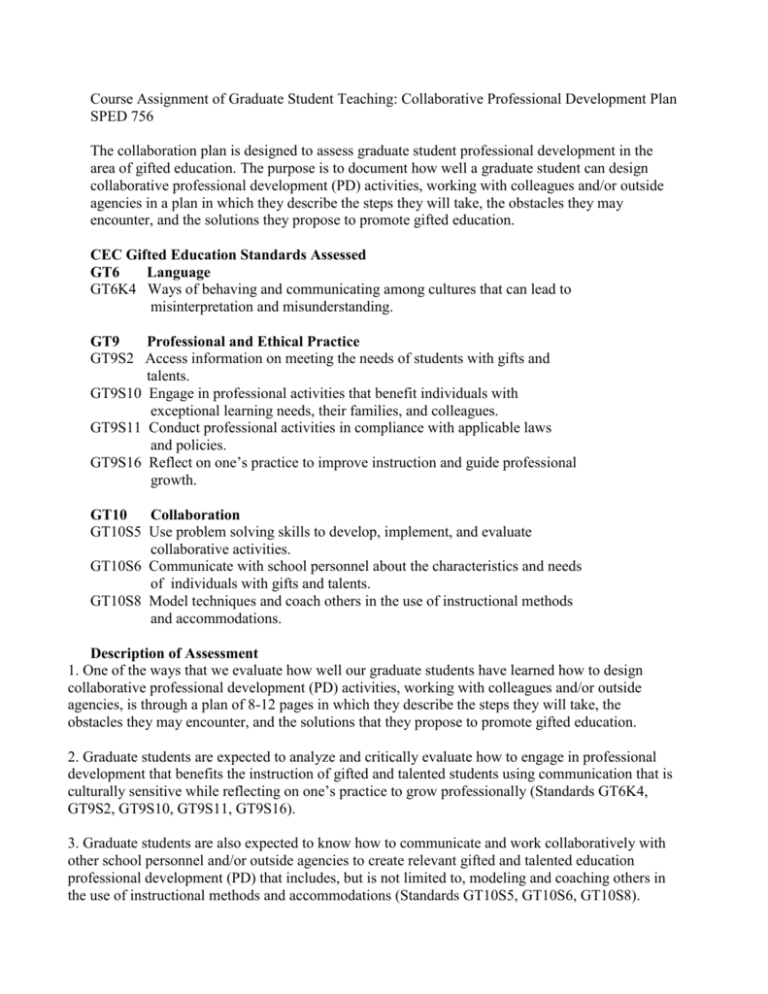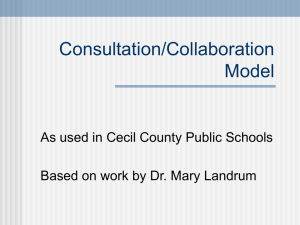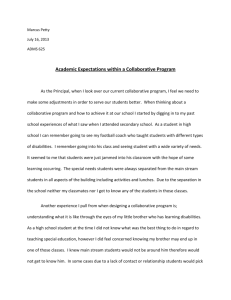GRADING RUBRIC Collaboration Plan SPED 756
advertisement

Course Assignment of Graduate Student Teaching: Collaborative Professional Development Plan SPED 756 The collaboration plan is designed to assess graduate student professional development in the area of gifted education. The purpose is to document how well a graduate student can design collaborative professional development (PD) activities, working with colleagues and/or outside agencies in a plan in which they describe the steps they will take, the obstacles they may encounter, and the solutions they propose to promote gifted education. CEC Gifted Education Standards Assessed GT6 Language GT6K4 Ways of behaving and communicating among cultures that can lead to misinterpretation and misunderstanding. GT9 Professional and Ethical Practice GT9S2 Access information on meeting the needs of students with gifts and talents. GT9S10 Engage in professional activities that benefit individuals with exceptional learning needs, their families, and colleagues. GT9S11 Conduct professional activities in compliance with applicable laws and policies. GT9S16 Reflect on one’s practice to improve instruction and guide professional growth. GT10 Collaboration GT10S5 Use problem solving skills to develop, implement, and evaluate collaborative activities. GT10S6 Communicate with school personnel about the characteristics and needs of individuals with gifts and talents. GT10S8 Model techniques and coach others in the use of instructional methods and accommodations. Description of Assessment 1. One of the ways that we evaluate how well our graduate students have learned how to design collaborative professional development (PD) activities, working with colleagues and/or outside agencies, is through a plan of 8-12 pages in which they describe the steps they will take, the obstacles they may encounter, and the solutions that they propose to promote gifted education. 2. Graduate students are expected to analyze and critically evaluate how to engage in professional development that benefits the instruction of gifted and talented students using communication that is culturally sensitive while reflecting on one’s practice to grow professionally (Standards GT6K4, GT9S2, GT9S10, GT9S11, GT9S16). 3. Graduate students are also expected to know how to communicate and work collaboratively with other school personnel and/or outside agencies to create relevant gifted and talented education professional development (PD) that includes, but is not limited to, modeling and coaching others in the use of instructional methods and accommodations (Standards GT10S5, GT10S6, GT10S8). GRADING RUBRIC Collaboration Plan SPED 756 In this course, candidates are required to design a professional development (PD) collaboration plan for their schools, working with professional colleague(s) and/or outside agencies. In lieu of a final examination, the students are asked to create a viable plan of 8-12 pages, double-spaced, providing a theoretically and empirically supported description of the steps they will take, obstacles they may encounter, and solutions they propose to promote gifted education. Assessment Performance Criteria 1. Content mastery Does Not Meet Standards Plan demonstrates little or no understanding of gifted education theory as it translates into collaborative, PD practice (GT9S2, GT9S10). Plan demonstrates a well-developed understanding of gifted education theory as it translates into collaborative, PD practice (GS9S2, GT9S10). 2. Critical thinking Plan includes little or no analysis of its strengths and weaknesses (GT9S16). Plan includes reasonably welldefended critical analysis of its strengths and weaknesses (GT9S16). 3. Divergent thinking Plan does not include implications for collaborative, PD activities (GT9S11, GT10S5). 4. Synthesis Plan is fragmented and does not provide a solid approach to collaborative PD activities in gifted education (GT9S11, GT10S6, GT10S8). The approach to collaborative PD, as reflected in the plan, involves behavior or communication that can lead to misinterpretation or misunderstanding among cultures (GT6K4). Plan is late, and/or writing is unclear and/or off topic with many errors in spelling and grammar. Plan includes productive, meaningful, and/or creative implications for collaborative PD activities (GT9S11, GT10S5). Paper provides a reasonably wellsupported approach to implementing and evaluating collaborative PD in gifted education (GT9S11, GT10S6, GT10S8). The collaborative PD, as reflected in the plan, does not involve behavior or communication that could lead to misinterpretation or misunderstanding among cultures (GT6K4). 5. Communication (professionalism of written communication) Meets Standards Writing is reasonably clear, effective, and focused with some errors in spelling and grammar. Exceeds Standards Plan demonstrates a welldeveloped understanding of complex principles of and research on gifted education theory as it translates into collaborative, PD practice GS9S2, GT9S10). Plan includes coherent and welldefended critical analysis of its strengths and weaknesses (GT9S16). Plan includes productive, insightful, and creative implications for collaborative, PD activities (GT9S11, GT10S5). Paper provides a solidly theoretical and empirically supported approach to implementing and evaluating collaborative PD in gifted education (GT9S11, GT10S6, GT10S8). The collaborative PD, as reflected in the plan, is explicitly sensitive to ways of behaving and communicating among cultures (GT6K4). Writing is clear, effective, and focused with very few errors in spelling and grammar.






